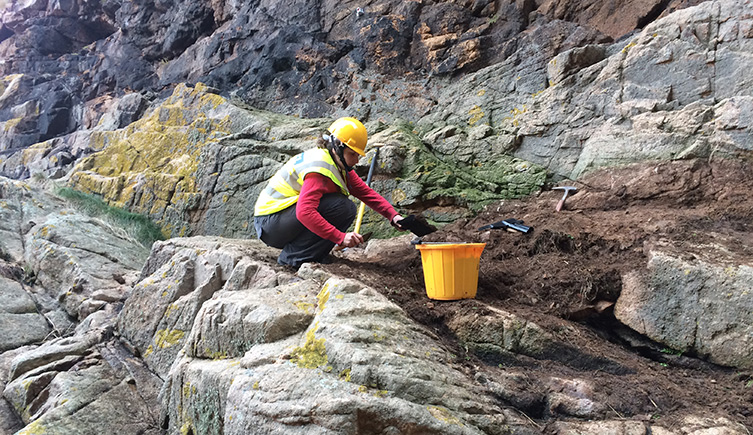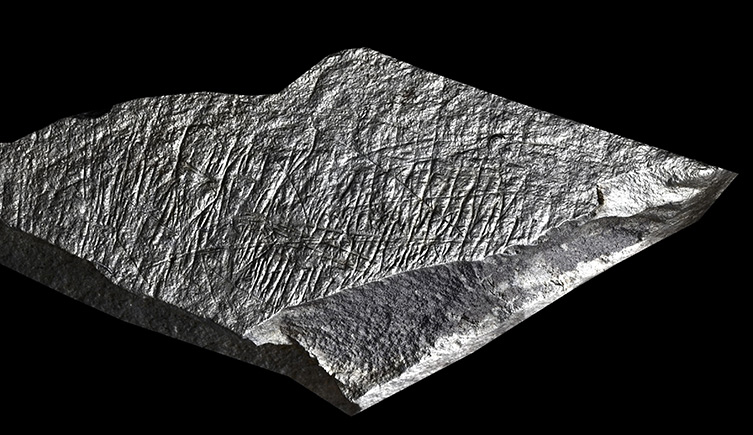Museum staff
- Silvia Bello
- Chris Stringer
- Tim Compton
- Louise Humphrey
- Simon Parfitt

Aerial view of the Neanderthal site of La Cotte de St Brelade, Jersey. The exceptionally low tides around the Channel Island of Jersey allow us to explore landscapes under the sea that were dry land during past glacial phases.
Focus: Hunter-gatherer response to changing climate in the western English Channel
Time period: 240,000-40,000 years ago
Funding:
Calleva Foundation (Pathways to Ancient Britain)
States of Jersey Tourism Development Fund
British Museum research fund
AHRC
British Academy
Jersey Heritage
We are investigating how animals and hunter-gatherers co-existed in landscapes now submerged beneath the English Channel, through new excavations and offshore and coastal surveys.
Resurveying the landscape around La Cotte de St Brelade on the island of Jersey has given us a new perspective on how this site may have functioned within its local landscape.
Rather than, as originally argued, functioning as a game drive site for hunting mammoths, we see La Cotte as offering an important vantage point for Neanderthal hunters exploiting these dissected landscapes.
Through reanalysis of stone tools from the site, we hope to extend these links into the wider offshore landscape.
Around 450,000 years ago, significant erosion of the Wealden-Artois chalk ridge linking Britain to the continent completely changed the offshore landscape west of the Straits of Dover. During cold periods, sea level dropped and a major river, known as the Channel River, occupied the deepest part of the Channel.
Neanderthals were active here from at least 240,000 years ago, collecting stone to make tools and hunting animals through landscapes that are now on the sea bed.
We are reconstructing the early human use of these landscapes and the animals they lived with, by studying sites on the Channel Island of Jersey and modelling the offshore landscape. We aim to better understand the changing people, animals and landscapes of the channel region over the last 240,000 years.
At La Cotte de St Brelade, excavations have revealed a deep sequence of Neanderthal occupation, spanning at least 240,000-40,000 years ago. We can relate changing behaviour at this site, and the animals humans butchered there, to larger scale landscape changes offshore.

Excavations at La Cotte on the Island of Jersey
The Channel Island of Jersey is mainly formed of igneous and metamorphic rocks, few of which can be easily made into stone tools.For at least 240,000 years, tools brought to the island were made from flint that people had collected from what is now the sea bed.
By matching up tools with the flint deposits they came from, we determined that sea level in the area must have been at least 40 metres below modern levels. This suggests that climate was cold, and therefore that a large volume of water was locked up in expanded global ice caps and glaciers.
Looking at the response of animal communities to shifts in climate and sea level allows us to study the changing adaptations of extinct species - as well as the people who preyed on them.
We are completing offshore surveys in two areas where Neanderthals are known to have been active:
Petit Portelet is less than 14 miles from the French coast and requires a sea level drop of only seven metres to reconnect it to the Cotentin peninsula, so is key to understanding how and when the island was connected.
This work will allow us to link the onshore story of Jersey to the broader palaeogeography of the Channel River and La Manche.
Excavations at two new sites in Jersey will allow us to investigate how humans were adapting to changing landscapes:

Photogrammetric model of an engraved piece of schist from Les Varines. This exotic, soft stone is not locally available, so must have been brought into the site. Analysis of the marks on its surface by Dr Silvia Bello shows that they were made with stone tools. Image courtesy of Dr Sarah M Duffy, Institute of Archaeology, UCL.
Excavations at Les Varines have produced more than 5,000 stone tools used at the camp, as well as enigmatic engraved pieces. The engraved pieces are produced on schist, an exotic stone imported into the site. The pieces have been incised with stone tools, and are currently being studied by Dr Silvia Bello.
We have also been undertaking rescue excavations in the west ravine at La Cotte de St Brelade. This key site is being destroyed by present-day sea level rise. In 1914, Neanderthal fossils were found in the deposits that are currently vulnerable to erosion, and these are currently being studied by Tim Compton, Professor Chris Stringer, and Dr Louise Humphrey.

Excavations at Les Varines
This research is part of Pathways to Ancient Britain (PAB), a suite of projects aimed at investigating the earliest occupations of Britain. PAB is funded by the Calleva Foundation.
Scott B, Bates M, Bates R, Conneller C, Pope M, Shaw A and Smith G (2014). A new view from La Cotte de St Brelade, Jersey. Antiquity, 88, pp 13-29.
Bates M, Pope M, Shaw A, Scott B and Schwenniger J (2013). Late Neanderthal occupation in North‐West Europe: rediscovery, investigation and dating of a last glacial sediment sequence at the site of La Cotte de Saint Brelade, Jersey. Journal of Quaternary Science. 28, 647-652.
Pope M et al (2015). Discoveries from La Manche: Five Years of Early Prehistoric Research in the Channel Island of Jersey. Archaeology International. 18, pp.113–123.
Conneller C, Bates M, Schadla-Hall T, Blinkhorn E, Cole J, Pope M and Shaw A (2016). Rethinking human responses to sea level rise: The Mesolithic of the Channel Islands. Proceedings of the Prehistoric Society.